|
ActionMedia II
@EFDC.ADF
- IBM ActionMedia (TM) II Display Adapter/A
@EFDC.ADF
- Intel DS2 Adapter same card / rename to @EFDC.ADF
191-189
PS/2 Actionmedia II Display Adapter/A 2MB, Capture Option
291-594
Actionmedia II Developer's Toolkit ver. 1.0
292-360
Actionmedia II Developer's Toolkit ver. 1.1
192-153
Actionmedia II Upgrade Kits (drivers only)
Action Media II
Delivery Card
Capture Card
Setting Jumper
E1 for Analog Keying
Upgrade
VRAM
Connectors and
Cables
Audio Signal Cable
Auxiliary Video Output Connector
Video Cable connector
Audio/Video Capture Cable
Audio/Video Capture Connector Pinout
Power Usage
ADF Sections
ActionMedia II From the Intel site.
Software and Drivers
Application & Technical Notes
ActionMedia®
II Resource List
ActionMedia II
Adapter/A
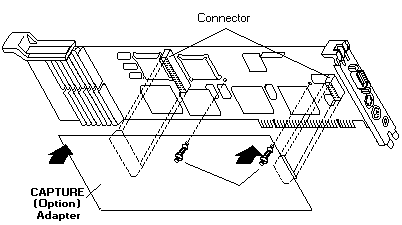
Delivery Card
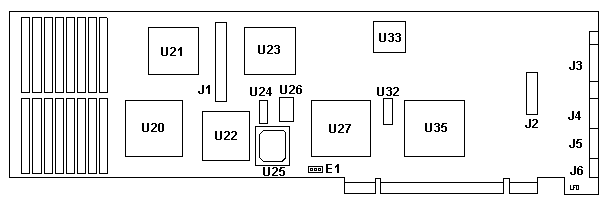
E1 Digital or Analog Keying
J1 60 Pin Header
J2 20 Pin Header
J3 Video Cable Connector
J4 S Video Connector
J5 Audio/Video Capture Connector
J6 Audio Signal Output
U20 Intel LV 2606103-0002 82750LV
VRAM Gate Array
U21 Intel 82750PB Pixel Processor
operating at 25 MHz, for compression and decompression of video. |
U22 Analog Devices ADSP-2105
U23 Intel 82750DB Display Processor
operating at up to 45 MHz. Supports VGA-, XGA-, NTSC-, and PAL-format monitors..
U24 25.0000 MHz Osc
U26 27C256-12 PLCC
U27 Intel LA 2606100-0001 82750LA
Audio Gate Array
U32 FPX16.9
U33 Analog Devices ADV476KP35E
U35 Intel LH 2606101-0002 82750LH
Host Gate Array |
Capture Card
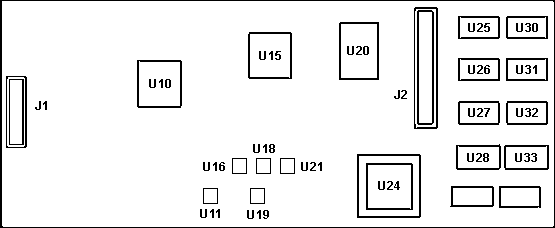
J1 20 Pin Header
J2 60 Pin Header
U10 Motorola PC44010A
U11 Intel N85C220
U15 Motorola XC44250FN
U16 Intel N85C220
U18 Intel N85C220 |
U19 Intel N85C220
U20 Motorola GSC38PG386CE02
U21 Intel N85C220
U24 PLCC
U25-U28 NEC D42101G-3
U30-U33 NEC D42101G-3 |
"CS-2" capture board
Jumper Block E1
Jumpered [1 2] 3 An RGB Overlay
Cable is installed and connected to the system's primary video source.
Analog keying is supported.
Jumpered 1 [2 3] The Delivery Board
is configured for digital keying. A VGA Feature Connector Cable should
be connected between the Delivery Board and the VGA connector on a VGA
board or motherboard.
NOTE: Only one type of keying should
be used.
| Description |
FRU P/N
|
Opt. P/N
|
| ActionMedia II Adapter/A |
69F9733
|
69F9732
|
| Capture Adapter |
69F9735
|
69F9734
|
| Video Cable |
69F9737
|
|
| Audio/Video Cable |
69F9736
|
|
| Display CD-ROM Cable |
69F9747
|
|
NOTE: The ActionMedia II Display
requires a 16 or 32-bit expansion slot with a video expansion
Upgrade
VRAM
VRAM memory that can be used to upgrade your ActionMedia® II
|
MANUFACTURER
|
PART #
|
|
Toshiba
|
524256AZ-10
|
|
Samsung
|
KM424C256Z-80
|
|
|
KM424C256Z-10
|
|
Texas Instruments
|
TMS44C251ASD-80
|
|
|
TMS44C251ASD-10
|
Single monitor configurations,
operating in either VGA 640x480 non-interlaced or in XGA (TM) 1024x768
interlaced modes, are supported when the text and graphics information
provided by the host PS/2 may be overlaid on the images provided by the
ActionMedia II
display adapters. In these configurations, the keying of the
overlay is controlled by the output of the host graphics adapter, such
that a zero (black) output results in the host information becoming
transparent to the images provided by the ActionMedia II adapter.
A dual-monitor configuration is
also supported, with one monitor used for the host's graphics adapter and
a second monitor used for the images provided by the ActionMedia II display
adapters, but that does not allow any host text or graphics overlay.
With the addition of the ActionMedia
II Capture Option, the display adapter's capabilities are extended to include
the capturing and digitization of audio and of analog video input signals
conforming to either NTSC or P.A.L. television standards, allowing
such signals to be monitored on the PS/2 display screen, captured as still
frames, or compressed in real time using the DVI Technology Real Time Video
capability.
MACHINE REQUIREMENTS:
The ActionMedia II Display Adapter/A 2MB can be installed in PS/2 machine
types 8555, 8557, 8565, 8570, 8573*, 8580, 8590, 8595, and the 7546 Industrial
Computers. Use of the ActionMedia II Audio Video Kernel requires
a minimum of 4MB of system memory. If additional OS/2 applications
are required to run in the PS/2, then a minimum of 6MB of system memory
is recommended.
* Models 161 and 401 only, and when configured for external display
only.
Supported graphics adapter and monitor cabling
configurations :
o A PS/2 color monitor connected to both the AM II display
adapter and the host VGA system using the AM II
Video Cable.
o A PS/2 color monitor connected to both the AM II display
adapter and the host XGA system or an XGA graphics
adapter using
the AM II Video Cable.
o A PS/2 color monitor connected directly to an AM II
display adapter and a second PS/2 monitor connected
directly to
the host VGA or XGA output connector.
PROGRAMMING REQUIREMENTS:
IBM OS/2 Version 1.3 is required for the installation of the Audio Video
Kernel Version 1.0 device drivers.
The MEDIAscript (3) OS/2 Desktop
Edition program product from Network Technology Corporation (NTC) is available
from NTC for those customers who require an OS/2-based ActionMedia II application
authoring and development environment.
Connectors
and Cables
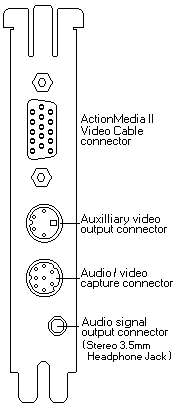
Audio Signal output connector
The Audio Signal output connector is
a 3.5mm standard stereo jack output connector. An amplifier, or active
speakers can be attached to the ActionMedia II Display Adapter/A. The input
impedance of the headphones or speakers should be at least 600 Ohms to
match the output impedance. Use of a lower impedance devices may cause
a POST error and a reduction in audio quality.
If you are going to use sound, a stereo amplifier or self-amplified
stereo device that can accept standard LINE-level audio output (0-2.0 Vp-p.)
from the Delivery Board. The audio device must have an input impedance
level of approximately 10 KOhms or greater.
Headphones are generally low-impedance devices. To use
headphones, plug them into an audio amplifier rather than directly into
the Delivery Board socket.
AM2 to ACPA Audio Cable

Auxiliary Video Output Connector
The Auxiliary Video Output Connector
(4-way DIN) allows connecting an ActionMedia II Adapter to an S-VHS
(also referred to as Y-C) video recorder or similar device. NOTE:
A cable is not supplied with the option.

|
Pin
|
Description
|
|
1
|
Y Video Ground
|
|
2
|
C Video Ground
|
|
3
|
Y Video Output
|
|
4
|
C Video Output
|
ActionMedia
II Video Cable connector
The ActionMedia II Video Cable connector
(15-pin) enables the ActionMedia II Display Adapter/A to take the video
signals from a normal PS/2 VGA or XGA display adapter, combine it with
ActionMedia II video signals, and send the mixed video signal to a PS/2
display.
Depending on the program, the presentation
on the PS/2 display is developed from either:
o VGA or XGA video signals,
o ActionMedia II video signals, or
o Mixed ActionMedia II and VGA or XGA video signals.
The default for the ActionMedia is to pass VGA or XGA video
signals to the PS/2 display.
RGB Overlay System (Analog Keying)
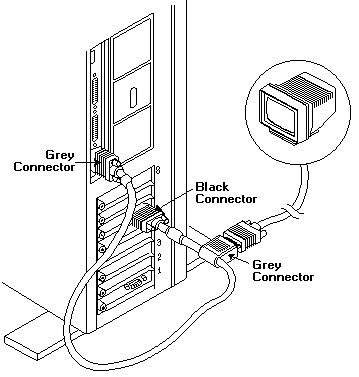
NOTE: Ensure that the connectors
(black and grey) are correctly connected. Any other cable connection may
cause the adapter to malfunction and cause damage to its internal components.
BLACK (short cable) end to ActionMedia II and the (longer cable) end with
GRAY connector to VGA (System board) or XGA adapter.
Video Cable
Pinout FRU 69F9737
This may not be perfect. NOTE: The (White)
Base Video HDD15 has Pin 9 missing, the (Black) AMII HDD15 has all pins
present.
Base (White)
Monitor AMII (Black)
1 - AMII (15) 1 - AMII (1)
1 - Mon 1
2 - AMII (4) 2 - AMII (2)
2 - Mon 2
3 - AMII (12) 3 - AMII (3)
3 - Mon 3
4 - Mon 4 4
- Base 4 4 - Base 2
5 NC
5 - AMII (10) 5 - Base 6-9,10
6 - AMII (5) 6 - AMII (7)
6 - Mon 7
7 - AMII (5) 7 - AMII (7)
7 - Mon 7
8 - AMII (5) 8 - AMII (8)
8 - Mon 8
9 NC
9 NC
9 - Base 14
10 - AMII (5) 10 - AMII (10) 10
- Mon 10
11 - Mon 11 11 - Base 11
11 - Base 13
12 - Mon 12 12 - Base 12
12 - Base 3
13 - AMII (11) 13 - AMII (13) 13 - Mon
13
14 - AMII (9) 14 - AMII (14) 14
- Mon 14
15 - AMII (15) 15 - Base 15
15 - Base 1
Audio/Video
Capture Connector
The Audio/Video Capture Connector (8-way
DIN) is only required when the Capture Option is installed.
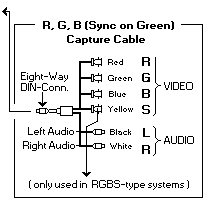
Capture cable connector
ID
| Video source |
R
|
G
|
B
|
Y
|
|
-Composite video 1 (VCR)
|
Yes
|
NC
|
NC
|
NC
|
| Composite video 2 |
NC
|
Yes
|
NC
|
NC
|
| SVHS (Y/C) |
Y
|
C
|
NC
|
NC
|
| RGB (sync-on-green) |
R
|
G
|
B
|
NC
|
| RGBS |
R
|
G
|
B
|
S
|
R= Red, B=Blue, G= Green, Y= Yellow
Capture Connector Pinout
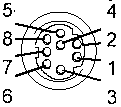
|
Pin
|
Description
|
|
1
|
Composite Sync Input
|
|
2
|
Blue Video Input
|
|
3
|
Red Video Input
|
|
4
|
Video Ground
|
|
5
|
Left Audio Input
|
|
6
|
Green Video Input
|
|
7
|
Right Audio Input
|
|
8
|
Audio Ground
|
Audio Source Device that provides
data at one of these levels:
High LINE level output of 6.0 Vp-p. maximum (audio CD interface).
Low LINE level output of 2.0 Vp-p. maximum (standard LINE interface).
MIC output of 60 mVp-p. maximum. If your microphone does not meet this
specification, a preamp may be necessary. Examples of such devices include
CD players , VCRs, and microphones.
Power Usage
When configuring a PS/2 System with
ActionMedia II, it may be necessary to limit the utilization of the system
expansion slots to avoid the possibility ov overloading the 12 volt power
supplies.
If the ActionMedia II Display Adapter/A
is being installed with the ActionMedia II Capture Option then, besides
the slot for the ActionMedia II Display Adapter/A, it is necessary to have
a minimum of either:
One empty
expansion slot, or One expansion slot occupied by an option card not requiring
+12 Vdc or -12 Vdc power. As a guide, it may be assumed that option cards
providing networking or communication support are likely to require
+12Vdc or -12Vdc power.
ActionMedia II Board Power Requirements
|
Voltage
|
Delivery Board
(2 MBytes VRAM)
|
CaptureModule
|
Total Power
|
|
+5 V
|
1200 mA
|
400 mA
|
8.0 W
|
|
+12 V
|
140 mA
|
190 mA
|
4.0 W
|
|
-12 V
|
60 mA
|
40 mA
|
1.2 W
|
Is anyone successfully using the ActionMedia II board to improve the
performance of Video for Windows and as a capture device. It
looks to
me from the Microsoft documentation that I will need INDEO drivers.
I
have the MCI and other Windows drivers for AM2.
Kevin Laux replied:
The INDEO drivers are included
with Video for Windows. If you go into the control panel and run
the drivers applet, you should see the INDEO driver. Click on setup which
will bring up a dialog box that has two checkboxes, one that says Software
only, the other says Hardware first, then Software. If the second
checkbox is grayed out, then there are several steps that you must take.
First of all, you must have
AM2MCI\BIN in your PATH. Then you must have a particular microcode
file in this directory that Video for Windows looks for in order to enable
the hardware assist. If you don't have the microcode file, which
is KE080201.BIN (I think; maybe it's KE080205.BIN), you must get the files
from Intel in Princeton, NJ (609-936-7611 is the Customer Support number
- leave a message and they'll call you back).
Once you have the appropriate
key microcode file, run the drivers
applet from the control panel. Choose Add, then Add updated or
unlisted
driver. Insert the Drivers diskette for Video for Windows and
indicate what floppy drive to the Add driver dialog (such as A:\).
Next a list of drivers will be displayed. Choose the INDEO driver.
You are reinstalling this driver. If it has already been installed,
you will be prompted whether to replace it or not. Choose New.
The driver will be reinstalled. You should then see a Message Box
saying that the AM2MCI software has been detected and has been updated.
I think you should also see the dialog box I described above concerning
the Hardware first, the Software.
Once, this is complete,
you'll be ready to play and capture AVI files
with AM II hardware assist. Note that you only get the assist
on AVI files
that are INDEO files. Actually they are RTV 2.1 files in an AVI
wrapper.
Lastly, this stuff is NOT
documented anywhere that I know of (well,
it is now that I've done this post :-)).
Oh, and finally, if you
don't have the AM2MCI software, you can call
Asymetrix and get into the Beta program - the latest release is Beta
3. The
phone number is 206-637-1660.
; Has anyone been able to use the IBM/INTEL
ActionMedia 2 card with a laser disc player? Specifically, I want
to use my PS/2 DV M57 486SLC2 to operate a Pioneer LD-V4400 player. IBM's
multimedia group in Atlanta says I can't do it ... that I would an M-motion
card to do what I want. I'm not sure I believe them. Suggestions as to
software which can do what I want are greatly appreciated.
George Mulford
With an ActionMedia II you can control the videodisc player using the
MCI
drivers from Pioneer (bulletin board number recently posted here).
You
can (alternatively) use the MCI drivers included in the most recent
version of the M-Control program from IBM; that's the only way
to control
a Pioneer 6000, as far as I know. But the M-Control Program is
and has
always been a separate product from the M-Motion card...more's the
pity,
if you bought an M-Motion and wondered where the drivers were!
You need the capture option on the ActionMediaII in order to do video
overlay. Now...maybe this is what Atlanta was saying: there
is no MCI
support for the overlay capability of the ActionMediaII. You
have to link
the AVK functions. Here I get fuzzy: there exists ToolBook
code to do
this, but it was only available in the "DVI ToolBook" that was in beta
test for a bit and has now been withdrawn? Have I got this right?
Is
anybody bossing the ActionMediaII from ToolBook without using the (now
black-market) beta DVI ToolBook?
Digital Video Arts has operating system support software for Windows
3.1 for the AM II card. Called the NewWorld Operating Environment,
it provides indeo acceleration, WAv driver support, digital video MCI device
driver support, AVI and AVS file support and more. Several utilities
are included for capture and coniversion of movies and still images.
Their phone number is (215) 586-7920.
>>We've purchased an IBM Action Media II board a while ago, and we've
captured some videos in AVSS format with it. Now that MMPM/2 is available,
it would be nice to play these videos without having the board installed.
Since AVSS seems not to be supported directly by MMPM/2, the AVSS files
probably need to be converted to AVI format. Does anybody know about a
converter for doing that or has experience in using AVSS files with MMPM/2?
>>
>AVSS files contain compressed video using either RTV or PLV proprietary
Intel algorithms. These data streams are rather computationaly complex
for realtime playback in software. I understand Intel provides a
utility that changes the file format to AVI format and converts the RTV
or PLV data to Indeo 2.1. Since the AMII had it's own audio formats, I've
heard that audio can be problematic depending on how the original clip
was created.
Well, having done a few....you
first of all need to capture using
RTV 2.1, not 2.0. It will take the audio out of the AVS file, an save
it
as a Wave file, to be integrated with the AVI file. But this utility
is
SLOW! It runs at 1 frame per second...even on a DX2/66 M77 machine!
There is another utility
called "SPLICE". It did faster
conversions...but again, it had to be RTV 2.1 captures. The New Version
of
Splice doesn't support AVS/DVI, so it is kinda useless.
IBM PC Server/IBM PS/2 - Automatic configuration problem with
ActionMedia/2 or Image Adapter/A Applicable to: World-Wide
Symptom:
After an Automatic Configuration, the adapter support drivers
for
ActionMedia/2 or Image Adapter/A will indicate the adapter is not
present, or is not functional (No video).
Details:
The current automatic configuration algorithm will always select the
adapter configuration address option that occupies the smallest
amount
of space in the "adapter ROM area." Depending on the software
set-up
options and application, this may not be adequate. These address
options are the same choices displayed during the manual "Change
Configuration" function. This will select "NO SPACE USED (DISABLED)"
for the ActionMedia/2 or Image Adapter/A ROM space.
Problem Isolation Aids: None
Fix:
Use the Reference Diskette (System Partition) "View Configuration,
Change configuration" function, to manually configure the ActionMedia/2
or Image Adapter/ROM address to a selection other than 'DISABLED'.
Software
AM2DRV.EXE:
v2.12 driver files for Win 3.x. Indeo(TM) Video v2.12, Indeo(TM)
YVU9 Video, PLV v2.0, and AVS.
AM2SET.EXE:
(v2.10). Setup and configuration
AM2DOC.PDF:
Hardware installation guide
AM2SFTDC.PDF:
Installation and troubleshooting for Win 3.x
AVSAVI.EXE:
Windows program which converts some AVS into AVI files.
am2os21.exe
558 Kb OS2 device driver v1.2 1/2
am2os22.exe
450 Kb OS2 device driver v1.2 2/2
am2win1.exe
271 Kb Windows driver v1.2, 1/2
am2win2.exe
463 Kb Windows driver v1.2, 2/2
DVision Cineworks
Tech
notes
ActionMedia®
II Resource List
Limitations
of Using the ActionMedia® II in Windows 3.x
ActionMedia®
II vs. Smart Video Recorder Pro Comparison
ActionMedia®
II End Of Life Letter
AdapterID EFDC IBM ActionMedia
II Display Adapter/A
Adapter I/O Addressing
This adapter occupies 64 bytes of I/O space which may
be located on any of the available 1024 byte boundaries.
<"I/O Addresses C000 - C03F" >,
C400 - C43F, C800 - C83F, CC00 - CC3F, B000 - B03F, B400 - B43F, B800 -
B83F, BC00 - BC3F
Extended Memory Window
The OS/2 and Windows drivers for this adapter require
an 8K window to operate. Some other drivers may require a 32K window -
see the information supplied with your driver in this case."
<"8K at Address C0000"
(C000-C1FF)>, C2000, C4000, C6000, C8000, CA000, CC000, CE000,
D0000, D2000, D4000, D6000, D8000, DA000, DC000, DE000, "32K at Address
C0000" (C000-C7FF), D0000, D8000, Disabled
Capture Option Interrupt Level
You can use interrupt 10 or 11 for the capture Even/Odd
interrupts.
<"Level 11">,
Level 10
Video Interrupt Level
You can use one interrupt from level 9 - 12
for Video interrupts.
<"Level 10">,
Level 11, Level 9, Level 12
Audio Interrupt Level
You can use level 10 or 11 for Audio
interrupts.
<"Level 10">,
Level 11
Adapter Memory Location
An 8KB block is needed only when the POST prom runs.
<"C0000-C1FFF">,
C2000-C3FFF, C4000-C5FFF, C6000-C7FFF, C8000-C9FFF, CA000-CBFFF, CC000-CDFFF,
CE000-CFFFF, D0000-D1FFF, D2000-D3FFF, D4000-D5FFF, D6000-D7FFF, D8000-D9FFF,
DA000-DBFFF, DC000-DDFFF, DE000-DFFFF
9595 Main
Page
|

